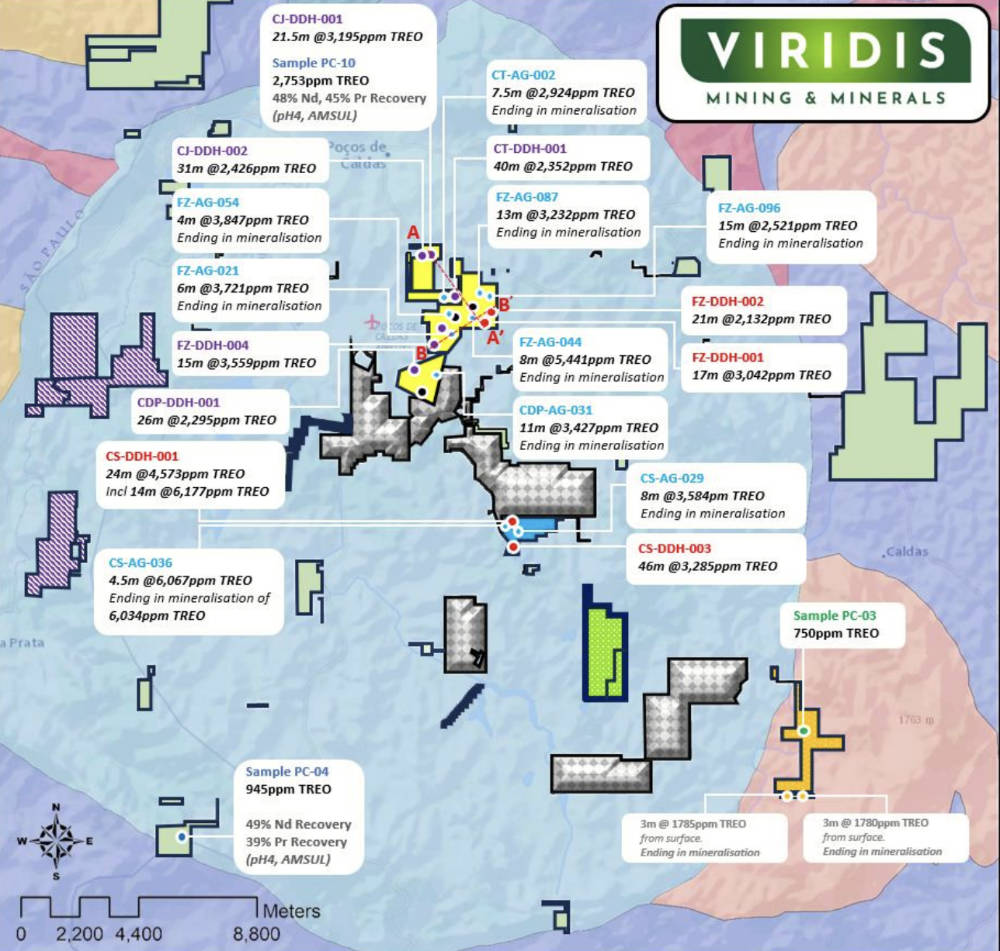Viridis goes Colossus with more high-grade hits at new rare earths project in Brazil

A stomping good time for Viridis as drilling intersects widespread REE mineralisation. Pic: via Getty Images.
- Viridis drilling intersects widespread ionic adsorption clay REE mineralisation at its Colossus project in Brazil
- Drilling has defined IAC bodies across three concessions, plus discoveries on two more concessions
- Auger, diamond and RC drilling continuing across the project
Special Report: Drilling at Viridis Mining & Minerals’ Colossus project in Brazil has returned significant assays, including a 21.5m hit of 3,195ppm TREO, confirming it hosts widespread, high-grade ionic adsorption clay rare earths mineralisation.
This is rapid progress for a project only acquired by the company in September after first signing the binding acquisition agreement at the beginning of August.
Colossus is in the Poços de Caldas complex – one of the largest intrusions in the world, within Brazil’s pro-mining state of Minas Gerais – and directly adjacent to Meteoric Resources’ (ASX:MEI) Caldeira ionic adsorption clay (IAC) project, which hosts a resource of 409Mt at 2,626 parts per million (ppm) total rare earth oxides (TREO).
Prior to Viridis Mining & Minerals (ASX:VMM) acquiring the project, the previous owners drilled 34 shallow auger holes that returned strong REE grades within heavily weathered clay and humic profiles.
This included a top hit of 3m grading 2,003ppm TREO from surface, ending in mineralisation.
Initial metallurgical work carried out by the company recovered significant amounts of valuable magnet REEs – used to fabricate permanent magnets found in electric vehicle magnets and wind turbines – through a single ammonium sulphate wash (pH4) at room temperature.
Average recoveries were 46% for neodymium, 40% for praseodymium, 38% for dysprosium and 35% for terbium – confirming the ionic nature of the Colossus saprolite mineralisation.
More recently, the company engaged the Australian Nuclear Science and Technology Organisation (ANSTO) to conduct comprehensive metallurgical test work for ionic desorption leaching.
Drilling delivers widespread REE results
The second set of assays from diamond drilling at the project has now defined IAC bodies across three concessions with discoveries on a further two concessions.

At the Fazenda prospect, four diamond holes have identified an IAC body with average thickness of ~14m and weighted average grade of 2,979ppm TREO.
It follows the latest hole returning a 15m intersection at 3,559ppm TREO (with 33% magnet REE content) within a broader 33.5m section at 2,509ppm TREO from surface.
Meanwhile, the first two diamond holes at the Carijo prospect have returned assays of 21.5m at 3,195ppm TREO (21% MREO) and 15m at 3,210ppm TREO (25% MREO), both within broader sections of 32m at 2,563ppm TREO and 31m at 2,426ppm TREO from surface respectively.
This has defined an IAC body with average thickness of ~18 metres and a weighted average grade of 3,201ppm TREO.
Additionally, the first and only diamond holes at the Central and Caminho Das Pedras prospects have returned intersections of 40m at 2,352ppm TREO (22% MREO) from 7m and 26m at 2,295ppm TREO (24% MREO) from surface.
VMM adds that auger drilling across the Fazenda and Caminho Das Pedras mining licences have returned wide-spread intersections of REE clay mineralisation.
Notable assays include:
- 7m at 4,882ppm TREO from 8m ending in 6,717ppm TREO;
- 13m at 3,232ppm TREO from surface and ending in 6,884ppm TREO; and
- 11m at 3,427ppm TREO from surface and ending in 3,296ppm TREO.
Drilling has also been very consistent in intersecting mineralisation with over 95% of the holes intersecting >1,000ppm TREO, while all 47 auger holes ended in REE mineralisation with grades increasing with depth.
Potential for ‘substantial REE resource’
“The Colossus project continues to deliver world-class IAC REE results across multiple concessions,” VMM executive chairman Agha Shahzad Pervez said.
“This set of results is groundbreaking for the company, with three additional high-grade discoveries at Carijo, Central and Caminho Das Pedras prospects identified through diamond drilling, of which the latter two adjoin the Fazenda concession.
“Combined with our first batch of results, we are demonstrating the entire northern concessions system has the potential to contribute to a substantial REE resource, alongside Cupim South, which holds the potential to be the highest-grade deposit within the entire complex from drill data we’ve received thus far – boasting an impressive weighted average grade of 3,460ppm across diamond drilling in a 15-45m thick IAC body.
VMM is continuing the auger, diamond and reverse circulation drill programs, geological mapping, geochemical and metallurgical tests, and mineralogical characterisation.
This article was developed in collaboration with Viridis Mining & Minerals, a Stockhead advertiser at the time of publishing.
This article does not constitute financial product advice. You should consider obtaining independent advice before making any financial decisions.
Related Topics

UNLOCK INSIGHTS
Discover the untold stories of emerging ASX stocks.
Daily news and expert analysis, it's free to subscribe.
By proceeding, you confirm you understand that we handle personal information in accordance with our Privacy Policy.








